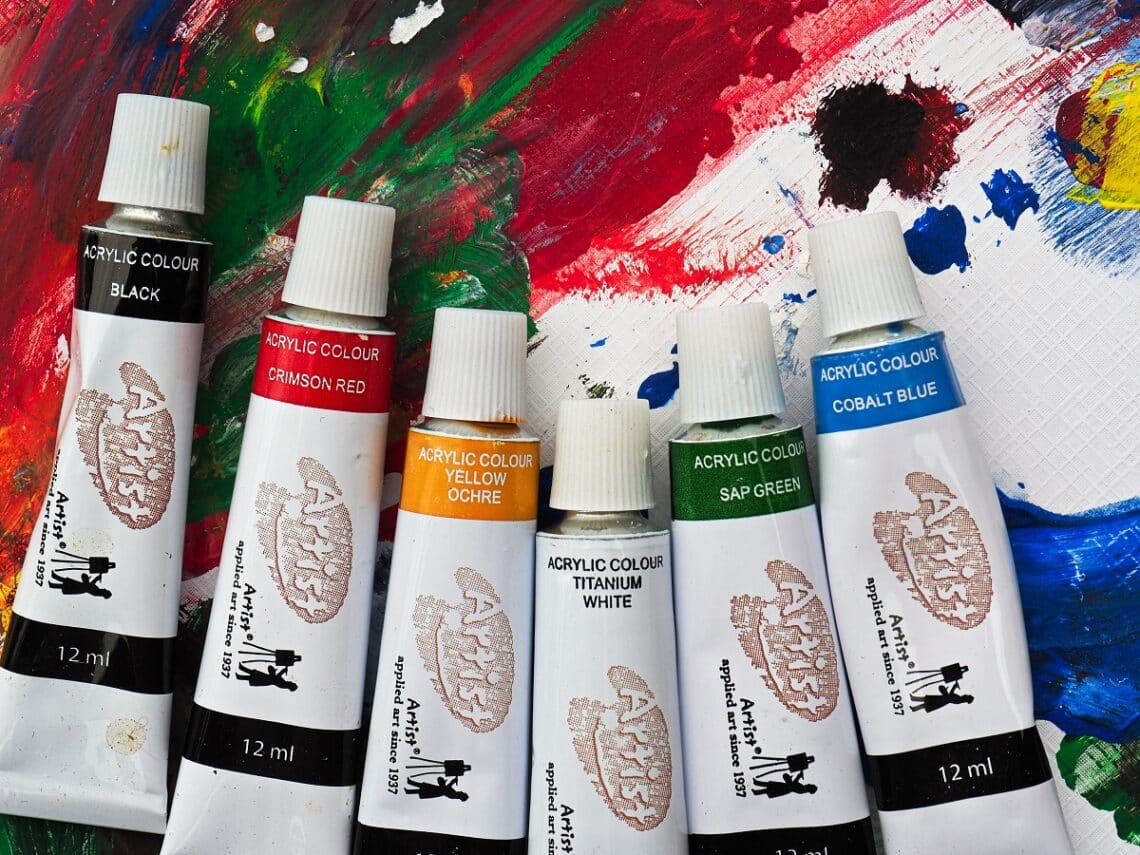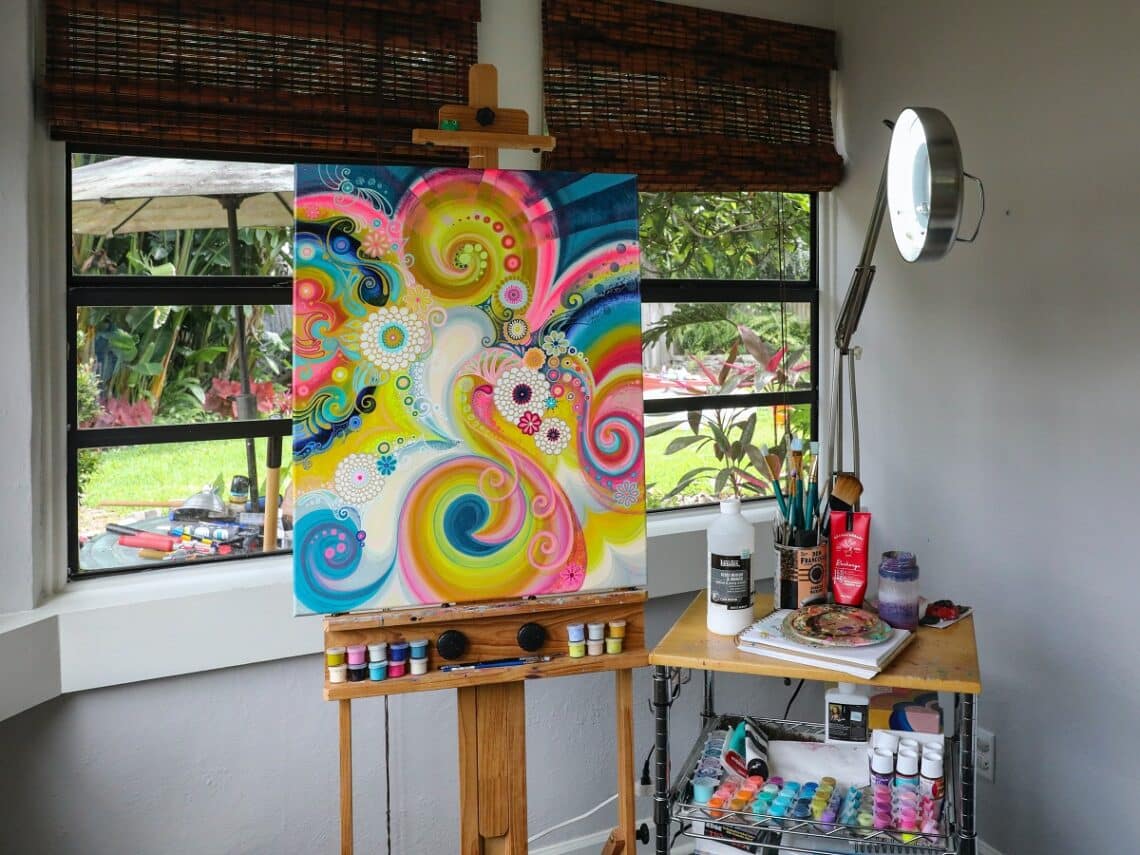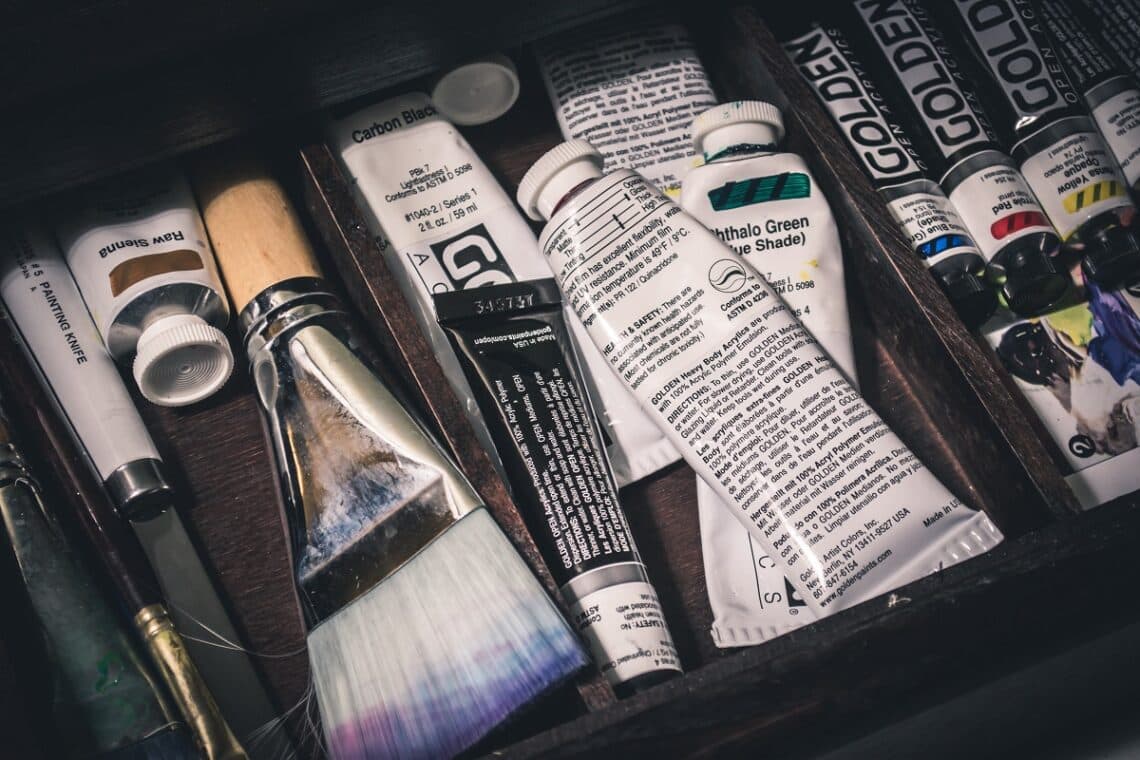Acrylic paints are incredibly popular among artists, and with the best brushes for acrylic painting, you can create a wide range of amazing artworks.
Additionally, they can be used on surfaces like wood, metal, ceramics, fabrics, etc, and are among the longest lasting types of paints you can get. They last as long as ten years when stored properly.
Another reason for their popularity is that they tend to dry quickly. The best-quality acrylic paints can dry in as little as ten minutes, though others may take some more time.
If you’re planning to use old acrylic paints, or want to learn about the best way of storing new ones, then this guide will help you out. It covers all the important aspects of acrylic paints and even contains some frequently asked questions on the subject.
So, make sure to read until the end to learn all about acrylic paints.
Can Acrylic Paint Get Spoiled?
Due to their chemical composition, acrylic paints do not have any expiry date. That said, they can still become unusable in certain conditions due to various factors. For instance, acrylic paint can degrade and become unusable even without being opened when exposed to extreme heat or cold.
This is because extreme temperatures can permanently alter the synthetic materials of these paints. Such temperatures can cause the emulsion to separate even in the case of unopened cans of paint. Additionally, acrylic paint is susceptible to freezing, developing mold, or drying out quickly.
But, if you store the paint correctly in an airtight container, it can last for quite a few years.
How Long Does Acrylic Paint Last After Being Opened?
![How Long Do Acrylic Paints Last? [All You Need To Know] 4 How long does acrylic paint last after being opened](https://dev.architecturelab.net/wp-content/uploads/2022/08/How-Long-Do-Acrylic-Paints-Last-2.jpg)
Once your acrylic paint has been opened, its shelf life can range from five to ten years, depending on its quality and storage. Unlike unopened ones, paints that have been opened once can go bad due to various reasons. The most common causes are drying out and contamination.
1. Bacterial Contamination
Bacterial contamination of acrylic paints can cause them to develop mold, and the paints will start to smell sour or rotten in that case. They may also acquire a curdled or clumpy appearance, but this generally does not happen in the case of unopened paint.
2. Drying
If you’re wondering how long does acrylic paint take to dry, then the answer is that it dries out very quickly once opened, taking mostly about 20 to 30 minutes. And, when that happens, it can have a shell or crust of dried paint on the surface. It may even dry up all the way through.
You can find out the shelf life of the paint by reading the product detail on the manufacturer’s website or it may be mentioned on the product label itself. However, remember that the shelf life estimate is based on the assumption that the paint is stored under ideal conditions, so it is best not to use old paint.
Reasons For Acrylic Paint Going Bad
Acrylic paint can get spoiled due to various reasons, such as:
1. Extreme Heat
The pigments, water, and polymer emulsion used to manufacture acrylic paints are highly susceptible to extreme temperatures. In extreme heat, the paint loses water quickly, becoming crusty and brittle as it dries up. To make use of it, you should always use wetting agents or a mixer.
2. Extreme Cold
Acrylic paints can separate on being exposed to extremely cold temperatures because they tend to freeze and break off. So, cold temperatures can turn the frozen paint into icicle-like structures which cannot be used for acrylic paintings.
3. Mildew And Mold
When acrylic paint becomes exposed to dirty water or moisture, it can lead to mold growth, making it unusable. This generally happens due to improper storage, as the place where you store the paint may already have mold growth, which can affect the paint.
Is It Possible To Use Expired Acrylic Paint?
Will acrylic paint be usable even after expiring? Well, it depends on two things – the nature and period of the degradation.
1. Nature Of Degradation
A. Exposure To Extreme Temperature
Even after mixing, a paint with clumps can get exposed to extreme temperatures, which starts altering its chemical composition. In such cases, you may be able to use it, but the pigment and texture may not match that of good quality paint. It is best to test it before using it on any important artwork.
B. Dry Paint
Old acrylic paint may dry out, especially when kept in storage for a long time. In such cases, check to see if it is completely dry throughout. Alternatively, if the paint only has a dry top layer or crust, it can be peeled, and the wet paint below can be used normally.
Completely dry paint can also be used but will require more effort to make it usable. Just make sure that it has not expired by checking its appearance and smell. It is best to avoid using it if it does not look or smell like regular acrylic paint anymore.
2. Period Of Degradation
Acrylic paint that has been in storage for a long time may have started to degrade. The longer it remains unused after being opened, the higher the chances of it going bad. That is why before using old acrylic paint, you should first check its condition.
Restoring Old Acrylic Paint
Before you get down to restore any acrylic paint that has been lying around in storage for a significant period, make sure it is not moldy or rotten. Paint that has started to rot or has mold growth should never be used and should be disposed of properly as it poses health risks.
But, if it has simply lost its regular texture or become dry, you can use these methods to try to restore it.
1. Improving The Texture
Temperature differences can cause impurities like small bumps to develop in acrylic paints if they are not stored properly. To remove them, you can use a mesh or a paint strainer if available. These can help remove the larger bumps from the paint that may be in the form of semi solids.
2. Restoring Dry Paint
There is one solution to fix paint that has completely dried but was not exposed to fresh air. However, this method often depends upon the quality of the paint. Artist quality acrylics can generally be fixed using this method as they are of a higher quality.
To do so, take a separate container and add a small amount of dry paint to it. Then, slowly add tap water to rehydrate it while avoiding thinning out the paint, and use a brush for spreading it . Let it rest for a couple of minutes and notice whether the water is changing color or not.
If it changes color, continue adding a few drops of water, but keep in mind that the water and paint should be in the same proportion for mixing. Keep stirring the paint until it regains its original consistency. And, if there is still too much dry paint left, add more water and let it sit for a few minutes. Continue mixing until it gets its natural consistency back.
Again, some particles may have been exposed to air and become chemically altered, so these should be filtered out using a strainer or removed using a toothpick or brush. You will also be unable to store restored paint, so make sure to mix as much as required.
Note that if the paint does not mix with water, it has become unusable and should be disposed of.
How To Store Acrylic Paint Properly
Since acrylic paint dries quickly, it should always be stored indoors and away from direct sunlight to ensure that it lasts for a long time. Ideally, the room temperature where it is to be stored should range from 65 to 75 degrees Fahrenheit.
Apart from that, the paint should be stored in an airtight container with tight-fitting caps or lids. In the case of tubes, make sure that the caps are screwed on properly, while cans should have their lids hammered down after each use. Cans with screw on lids can be sealed using plumber’s tape.
To prevent contact with contaminants or air, store the paint container in another larger airtight container. In case of a large collection of art materials, the garage is generally a preferred storage location, but you should make sure that there is no mold.
Mold grows quickly where there is moisture, so avoid storing acrylic paint in areas such as those with running water, exposed concrete or wood, working furnaces, etc. You can also add mold inhibitors to the paint to store it for longer periods, while moisture-absorbing packets can be placed in the larger container.
How Long Do Acrylic Paints Last Frequently Asked Questions ?
Which Art Paint Lasts The Longest?
Acrylic paint is one of the most durable art paints since it has a long lifespan and does not fade easily on exposure to sunlight. Besides that, oil paint is another long lasting option.
How To Make Acrylic Paint Last Longer?
Acrylic paint requires the application of a varnish sealer to help it last longer, but you should always make sure that it is completely dry before application. Also, apply the first coat of paint using a wide base coat brush, and then wait for it to dry before applying the second coat.
How To Clean An Acrylic Painting?
Use a white cotton cloth soaked in soapy water to wipe your acrylic painting and remove any stains or smudges. However, be gentle while wiping and do not apply force on the painted surface as that can damage the painting. That’s how you clean an acrylic painting without any trouble.
![How Long Do Acrylic Paints Last? [All You Need To Know] 5 How long do acrylic paints last final thoughts](https://dev.architecturelab.net/wp-content/uploads/2022/08/How-Long-Do-Acrylic-Paints-Last-3.jpg)
How Long Do Acrylic Paints Last Final Thoughts
Proper storage is always important to ensure that your acrylic paint lasts for a long period. And, the longer the storage period, the more important it is to follow the proper storage methods.
On the other hand, if you use the paint frequently, it is necessary to prevent its exposure to extreme temperatures since the separation of emulsion does not require much time to occur. Although sometimes you may be able to restore the paint to a usable condition, it is not always possible, and even then, it may not provide the desired results.
Finally, go with good quality professional paints which can deliver a better experience and last longer.
We’ll be back soon. Goodbye!






![How Long Do Acrylic Paints Last? [All You Need To Know] 1 How long do acrylic paints last](https://dev.architecturelab.net/wp-content/uploads/2022/08/How-Long-Do-Acrylic-Paints-Last-1.jpg)